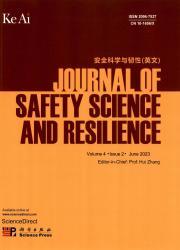基于性能状态转换的城市生命线系统运行弹性演化模型
IF 3.4
Q1 PUBLIC, ENVIRONMENTAL & OCCUPATIONAL HEALTH
引用次数: 0
摘要
为了更好地理解城市生命线系统在长运行周期内的弹性演化动态,本研究引入了一个受易感-感染-恢复(SIR)模型启发的模型,该模型传统上用于模拟人口健康转变。通过分析灾害情景下城市生命线系统性能状态演变的控制机制,将灾害情景模型与弹性评估方法相结合,综合考虑弹性的三个关键组成部分——抵抗、恢复和适应性,建立了系统动力学弹性可靠性模型。通过一个假设的案例研究来验证模型的适用性。结果表明,抵抗、恢复和适应性的相互作用影响了系统性能在残疾性能、生存性能和恢复性能三种状态下的动态演化。该模型揭示了弹性增强的周期性模式,适应性成为关键决定因素。此外,SDR-R模型不仅模拟了单一灾害情景下的城市生命线性能状态演变,还捕捉了长期系统运行的弹性演变趋势。案例研究结果表明,随着灾害严重程度的加剧,恢复力会下降,但适应性的积极反馈会随着时间的推移促进恢复力的提高。弹性演化过程可分为初始冲击、自适应启动、自适应增强和阈值效应四个阶段。值得注意的是,不同灾害级别的恢复力动态差异很大。虽然系统在低级别灾害情景下表现出高弹性,但在中、高级别灾害情景下,弹性逐渐稳定在高水平。然而,极端灾害使复原力出现更大波动,强调有必要制定有针对性的增强复原力战略。本研究为理解城市生命线弹性演化和制定增强系统稳健性的策略提供了方法论指导。本文章由计算机程序翻译,如有差异,请以英文原文为准。
A resilience evolution model of urban lifeline systems during operation based on performance state transitions
To better understand the resilience evolution dynamics of urban lifeline systems over extended operational periods, this study introduces a model inspired by the susceptible-infected-recovered (SIR) model, which is traditionally used to simulate population health transitions. By analyzing the mechanisms governing the performance state evolution of urban lifeline systems under disaster scenarios, integrating a disaster scenario model with resilience assessment methodologies, and comprehensively considering three key resilience components—resistance, recovery, and adaptability—we develop a system dynamics resilience‒reliability (SDR-R) model. A hypothetical case study is conducted to validate the model’s applicability. The results indicate that the interplay of resistance, recovery, and adaptability influences the dynamic evolution of system performance across three states: disability performance, survivability performance, and recovery performance. The model reveals a cyclical pattern in resilience enhancement, with adaptability emerging as a critical determinant. Moreover, the SDR-R model not only simulates urban lifeline performance state evolution under single disaster scenarios but also captures resilience evolution trends over long-term system operations. The case study findings reveal that resilience decreases as disaster severity intensifies, yet positive feedback from adaptability fosters resilience improvement over time. The process of resilience evolution can be divided into four distinct phases: initial impact, adaptive priming, adaptive enhancement, and threshold effect. Notably, resilience dynamics vary significantly across disaster levels. While systems exhibit high resilience under low-level disasters, resilience gradually stabilizes at a high level in medium- and high-level disaster scenarios. However, extreme disasters introduce greater fluctuations in resilience, underscoring the necessity for targeted resilience-enhancing strategies. The insights derived from this study offer methodological guidance for understanding urban lifeline resilience evolution and developing strategies to enhance system robustness.
求助全文
通过发布文献求助,成功后即可免费获取论文全文。
去求助
来源期刊

安全科学与韧性(英文)
Management Science and Operations Research, Safety, Risk, Reliability and Quality, Safety Research
CiteScore
8.70
自引率
0.00%
发文量
0
审稿时长
72 days
 求助内容:
求助内容: 应助结果提醒方式:
应助结果提醒方式:


